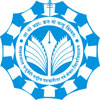
Ethical Challenges for PR Professionals in Combating Fake News and Misinformation: An Analysis
Kajal Verma[1]
Shalini Saraswat[2]
Abstract
The digital age has transformed the landscape of public relations (PR), bringing both opportunities and challenges for PR professionals. One of the most pressing issues is the rise of fake news and misinformation, which undermines trust and presents significant ethical challenges. This paper explores the evolution of PR ethics in the context of these new realities, focusing on how PR professionals navigate the tension between transparency, credibility, and the pressure to deliver rapid results in an increasingly fast-paced digital environment. Through an analysis of case studies, existing literature and questionnaire, the study investigates the strategies employed by PR practitioners to combat misinformation, maintain ethical standards, and protect the integrity of both their organizations and the public sphere. This research also examines the role of social media platforms in disseminating information and the ethical implications for PR professionals, who must balance the need for effective communication with a commitment to truth and accountability. Ultimately, the paper provides insights into how the PR industry is adapting its ethical frameworks to address the complexities of the digital age.
Keywords: Public Relations, Fake News, Misinformation, Social Media, New Media
Introduction
The public relations (PR) industry plays a crucial role in shaping public perception and fostering trust between organizations and their stakeholders. In an era defined by rapid technological advancement, PR industry has undergone significant transformation, particularly with the widespread adoption of digital platforms. Over the years, the emergence of digital technologies and social media platforms has revolutionized the way PR professionals engage with audiences, offering new avenues for engagement, influence, and relationship-building. These platforms have not only accelerated the speed of communication but also broadened the reach of messages, allowing organizations to connect directly with diverse and global audiences. This shift has empowered PR practitioners with innovative tools for storytelling, audience engagement, and brand reputation management.
However, this digital evolution has also brought forth complex ethical challenges, particularly in the form of fake news and misinformation. Misinformation—false or misleading information shared regardless of intent—has become a pervasive issue, amplified by the speed and reach of social media platforms. Fake news, which often involves deliberately fabricated stories, further compounds the problem by manipulating public opinion and eroding trust in credible sources. As the speed and reach of information have dramatically increased, so too has the potential for the dissemination of false or misleading content, which can damage reputations, manipulate public opinion, and erode trust in both media and institutions. It spreads faster than factual information, often through viral posts, memes, and algorithm-driven content prioritization.
For PR professionals, who are tasked with managing organizational reputation and fostering transparent communication, the rise of misinformation poses a direct threat to the core principles of the industry:honesty, credibility, and public trust. Navigating these challenges requires a deeper understanding of both traditional PR ethics and the evolving digital landscape. The pressure to respond quickly to misinformation, while maintaining ethical integrity, highlights the complexity of this issue. The spread of fake news and misinformation has societal implications, as it influences public opinion, decision-making, and democratic processes. In this context, PR professionals face a dual responsibility of countering misinformation effectively and maintaining public trust. They are required to find new ways to uphold ethical standards while ensuring that accurate and reliable information reaches the public.
This paper aims to explore the evolution of PR ethics in the digital age, focusing on how PR professionals address the ethical dilemmas posed by the proliferation of fake news and misinformation. By examining case studies, analysing current practices, and evaluating the role of social media in these ethical issues, this study seeks to understand how the PR industry is adapting to these new challenges. The findings of this research offer insights into how PR professionals can maintain ethical integrity, foster public trust and how the PR industry can navigate this complex landscape while upholding its ethical commitments in a world where information—and misinformation—travels faster than ever before.
Objectives
- To examine the ethical challenges faced by PR professionals in addressing the spread of fake news and misinformation in the digital
- To analyse the strategies employed by PR professionals to uphold transparency, credibility, and public trust amidst the rise of
- To explore the role of social media platforms in shaping PR ethics and communication practices in response to misinformation.
Review of Literature
Johnson and Lee(2019) explored fake news’s impact on brand credibility, highlighting the pressure on PR practitioners to respond swiftly to viral content, which can sometimes lead to prematurely labeling news as “fake.” They advocate for a fact-based approach and partnerships with reliable media to maintain credibility. Similarly, Jones and Smith (2020) examined the ethical challenges in digital public relations, focusing on how misinformation complicates PR professionals’ role in balancing truth with managing public perception. They argue that digital platforms’ rapid information spread complicates the fight against false narratives, calling for a stronger commitment to transparency and accuracy to build public trust. Williams and Patel(2021) emphasized digital literacy asessential for PR ethics, suggesting that PR practitioners face ethical challenges in distinguishing credible sources online. Their study recommends integrating digital literacy training into PR ethics education, enhancing practitioners’ ability to navigate misinformation responsibly.
Garcia and Thompson (2022) proposed a framework to address the ethical duties of PR professionals in combatting misinformation. They advocate for transparency, proactive engagement, and fact-checking, suggesting that ethical PR involves educating the public and actively countering misinformation. Collectively, these studies highlight the evolving ethical responsibilities in PR to address misinformation in the digital age. Lambert, Ewing and Hassan (2024) did thematic analysis of the responses from in-depth interviews and Focus Group Discussions conducted with Senior PR practitioners to explore the decision-making strategies they apply in response to fake news. The findings provide valuable insights into several aspects of public relations practitioners’ handling of fake news crises in corporate settings. It included their criteria for determining the necessity and timing of responses, the range of strategies they are empowered to deploy, and their techniques for managing media narratives during such corporate crises stemming from misinformation.
Jahng, Lee and Rochadiat (2020) surveyed PR practitioners through questionnaire regarding their knowledge and concept of fake news and the strategies they employ to cross-check the information distinguishing it from fake information and fake news and did the thematic analysis of their responses. Intentional manipulation and content aimed at tarnishing reputations were considered main identifiers of fake news. The results of study revealed that practitioners use conventional news and collaborative input from large group of people- crowdsourcing approach for identification. Fârte and Obadă (2018) studied the issue of addressing fake news from an organizational standpoint. For, PR strategies have been used, reactive specifically. The authors defined ‘fake news’ term and divided it into ten categories namely, clickbait, parody, imposter content, misinformation, misleading content, false connection, false content, manipulated content, and, fabricated content. It proposed a three-dimensional conceptual model of fake news within an organizational setting. The study mentions that PR managers can employ reactive PR strategies to combatonline fake news about their company or utilize communication strategies to temporarily transform the organization served into a potential source of fake news.PR managers can employ a variety of reactive PR strategies to counteract fake news, or different communication stratagems as per the PR objectives to achieve organizational goals.
Edwards (2020) contended that disinformation and fake news have long been used as tools in public relations (PR) practices, contributing to the ongoing crisis in the field. Based on an exploratory analysis of UK industry publications concerning fake news and disinformation, the study revealed that the PR sector has approached disinformation as both a business opportunity and a means to enhance its professional credibility. The narratives crafted by PR professionals portray their practices as ethical, reliable, and truthful, while distancing themselves from questionable methods and normalizing the concept of “organized lying.” To effectively address the issue of disinformation, the study concluded that it is essential to recognize the significant role that public relations plays in this context. Santas and Garba (2024) in a study, opined that a significant gap exists concerning the most successful public relations techniques and approaches for countering misinformation and advocating for evidence-driven policies that support sustainable development. To bridge the gap mentioned above and explore effective PR techniques, and their influence on the public, the authors conducted a study using a mixed-method research approach incorporating interviews and surveys. Their findings revealed that well-planned PR efforts are crucial for spreading accurate information and addressing misinformation. The study suggested a greater emphasis on improving media literacy and analytical thinking abilities, encouraging collaboration among PR experts, scientists, and policymakers, customizing communication tactics according to the respective platform, evaluating PR campaigns, and building partnerships with all stakeholders.
Research Gap
Despite the substantial body of literature addressing the ethical challenges faced by PR professionals in combating fake news and misinformation, several critical research gaps persist that merit further investigation. First, while studies like those by Garcia and Thompson (2022) propose frameworks for ethical responsibilities, there is a noticeable lack of comprehensive, universally applicable models that can be effectively utilized across various organizations and cultural contexts. The development of adaptable frameworks could empower PR practitioners to navigate misinformation more successfully, tailoring strategies to meet the unique demands of their industries.
Furthermore, the current discourse emphasizes the need for digital literacy training as a means to combat misinformation, yet there is insufficient empirical evidence assessing the effectiveness of such programs. Research into the specific types of training that enhance practitioners’ capabilities to distinguish credible sources from misinformation is crucial for establishing best practices in the field. Additionally, emerging technologies such as AI and data analytics present another gap, with limited exploration of their role in boosting transparency and accountability in PR strategies, alongside the ethical implications these tools entail. Another area requiring further exploration is the longitudinal impact of misinformation on brand reputation and public trust. Much of the existing literature focuses on immediate response strategies, neglecting the long-term consequences of persistent misinformation exposure. Longitudinal studies could offer valuable insights into how such exposure affects public perception over time, guiding PR professionals in developing effective crisis management strategies.
Moreover, much of the current research is rooted in Western contexts, which leaves a significant gap in understanding how different cultures perceive and respond to misinformation within PR practices. Cross-cultural studies could elucidate cultural nuances, thereby enhancing the global applicability of PR guidelines and strategies. Additionally, while the strategic responses of PR professionals have been well examined, less attention has been given to the psychological and emotional impact of dealing with misinformation on practitioners themselves. Investigating these dimensions could provide a more holistic understanding, paving the way for tailored support systems that address the unique challenges faced by PR professionals. Finally, the influence of social media algorithms on the dissemination of misinformation remains underexplored. As these algorithms significantly shape content visibility, examining their impact on PR strategies’ effectiveness in countering misinformation is imperative. By addressing these research gaps, scholars can contribute essential insights that enhance the ethical practices and strategic responses of public relations professionals in an increasingly complex digital landscape.
Methodology
This study used a descriptive research design to analyze and outline the ethical challenges PR professionals face due to the rise of fake news and misinformation. The methodology incorporated a mixed-methods approach, integrating questionnaires as the primary tool for data collection and analysis of secondary data including case studies. Snowball sampling was used because there was no comprehensive list of individuals to reach potential respondents. An online survey was conducted to enhance accessibility and convenience for participants. The questionnaire followed a mixed-methods approach to collect both qualitative and quantitative data. It was divided into two sections:
- Awareness and opinions regarding the ethical challenges PR professionals face in the context of fake news and misinformation.
Ethical Challenges in PR: Case Studies on Combatting Fake News and Misinformation
Coca-Cola’s Response to Misinformation: In 2020, Coca-Cola faced numerous false claims regarding its products’ health effects amid the COVID-19 pandemic. The company employed a multi-faceted strategy that included rapid fact-checking, collaboration with credible health organizations, and transparency about their product ingredients. By promoting accurate information through its channels and addressing misinformation directly, Coca-Cola reinforced its commitment to consumer trust and brand credibility.
Princeton University and the “Princeton Mom” Controversy: In 2013, a Princeton alumna’s blog post titled “Why You Shouldn’t Tell Your Daughter She Can Be Anything She Wants” garnered widespread attention and sparked public debate. The university’s PR team faced the challenge of addressing misleading interpretations of the blog that painted it as representative of Princeton’s values. The PR response involved issuing clarifications and amplifying the voices of female leaders and scholars from the university to present a more nuanced view, emphasizing the institution’s commitment to gender equality and academic freedom.
Healthcare Sector and Vaccine Misinformation: During the COVID-19 pandemic, various healthcare organizations, including the World Health Organization (WHO), encountered rampant misinformation about vaccines. In response, these organizations launched comprehensive public relations campaigns focused on educating the public through transparent messaging, collaboration with social media platforms to flag misinformation, and the use of data-driven approaches to reach audiences effectively. This case illustrates the importance of proactive engagement and partnerships in counteracting misinformation in high-stakes contexts.
Facebook’s Role in the 2016 U.S. Presidential Election: Facebook has been criticized for its role in disseminating fake news during the 2016 U.S. presidential election, which significantly impacted public opinion. In response to backlash, Facebook implemented initiatives aimed at increasing transparency, such as labeling and reducing the reach of false information. The case exemplifies the ethical challenge of balancing platform integrity with user engagement, highlighting the responsibilities of social media companies and PR practitioners in combating misinformation.
Nestlé and Baby Formula Misinformation: Nestlé has had to combat various misinformation campaigns regarding its baby formula products, particularly in developing countries where breastfeeding is often emphasized. The company faced backlash when false claims circulated about the dangers of its formula. In response, Nestlé’s PR strategy involved collaborating with healthcare professionals, providing accurate information through targeted campaigns and promoting its commitment to responsible marketing practices. This case highlights the ethical imperatives of transparency and the need for corporate social responsibility in addressing misinformation.
Volkswagen Emissions Scandal: In 2015, Volkswagen was embroiled in a scandal involving falsified emissions data. The company’s initial response was marked by a lack of transparency, which compounded the damage to its reputation. The PR strategy evolved to prioritize honesty, with executives publicly acknowledging the wrongdoing, outlining steps for remediation, and committing to more sustainable practices. This case demonstrates the importance of swift and transparent communication in regaining public trust after misinformation or deceit has been uncovered.
Data Interpretation and Analysis
1. The most significant ethical challenge in public relations today is a topic of debat
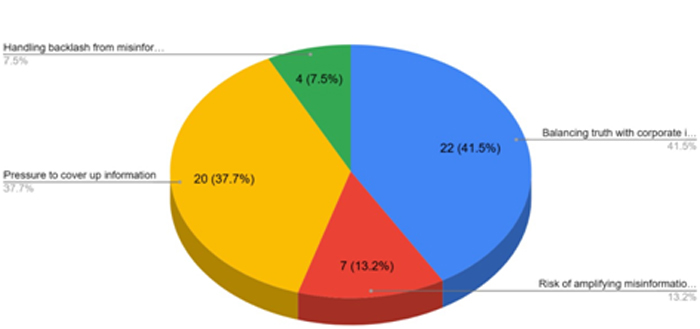
The pie chart illustrates opinions on the most significant ethical challenges in public relations (PR). The highest concern, chosen by 41.5% of respondents ,is “Balancing truth with corporate interests.” This reflects the difficulty PR professionals face in maintaining honesty while aligning with business goals, which can create ethical conflicts. The lowest concern, at 7.5%, is “Handling backlash from misinformation.” This suggests that while managing misinformation is important, it is perceived as a less immediate or frequent challenge compared to others like transparency or integrity.
2. There is a growing consensus that the PR industry requires stricter ethical guidelines to effectively combat misinformation.
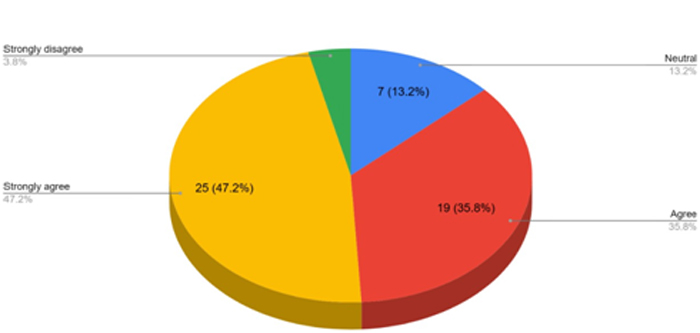
The pie chart shows opinions on whether the PR industry needs stricter ethical guidelines to handle misinformation. The highest response, at 47.2%, is “Strongly agree,” indicating that many believe stronger guidelines are essential to address growing challenges with misinformation effectively. The lowest response, at 3.8%, is “Strongly disagree,” suggesting very few think existing guidelines are sufficient, highlighting a consensus on the need for improvement in ethical practices.
3. Organizations frequently engage in fact-checking and collaborate with third-party verifiers before disseminating information to the public.
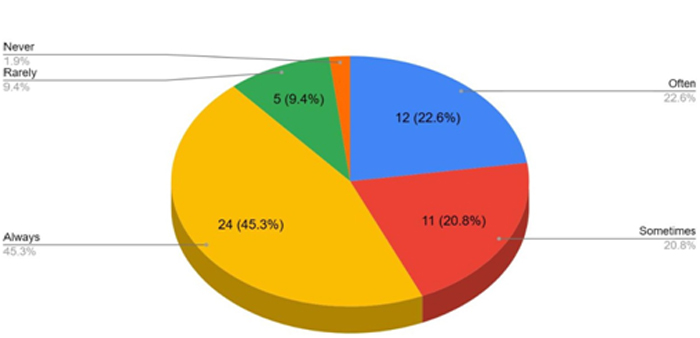
The pie chart shows how often organizations engage infact-checking or collaborate with third-party verifiers before sharing information with the public. The highest response, at 45.3%, is “Always,” indicating that most organizations prioritize accuracy and credibility in their communications to maintain trust. The lowest response, at 1.9%, is “Never,” showing that very few organizations neglect fact- checking, likely due to the risks of misinformation damaging reputation and public trust.
4. Transparency efforts in public relations have a positive impact on public trust.

The pie chart shows how people think transparency in PR impacts public trust. The majority (50.9%) believe it impacts public trust “very positively,” likely because transparency builds credibility and strengthens relationships by reducing skepticism. On the other hand, only 3.8% feel it impacts trust “very negatively,” possibly due to concerns about excessive disclosure or mishandling of information leading to misunderstandings. The highest percentage reflects the trust-enhancing power of openness, while the lowest highlights that such concerns are minimal.
5. Certain social media practices are crucial for upholding ethical standards in public relations.
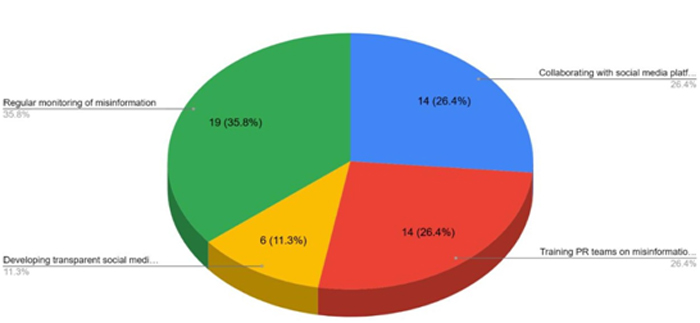
The pie chart shows opinions on the most crucial social media practices for maintaining ethical PR standards. The highest response, at 35.8%, is “Regular monitoring of misinformation, “emphasizing the importance of actively identifying and addressing false information to maintain credibility and trust. The lowest response, at 11.3%, is “Developing transparent social media policies,” suggesting that while policy development is valuable, it may be seen as less immediate or impactful compared to proactive actions like monitoring.
6. Organizations often utilize social media platforms to counter misinformation.
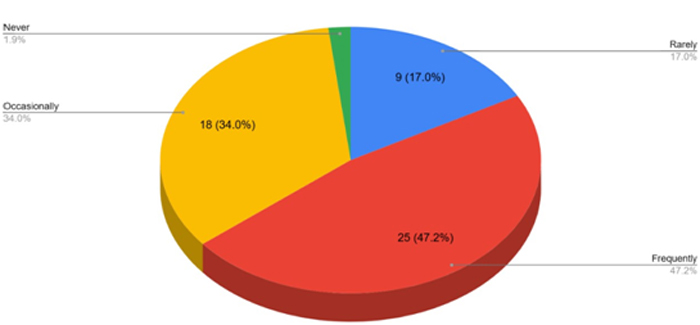
The pie chart shows how often organizations use social media to address misinformation. The highest percentage (47.2%) represents organizations that “frequently” use social media for this purpose. This might be because social media is a primary source of information for many, making it essential to counteract false narratives quickly and effectively. The lowest percentage (1.9%) shows organizations that “never” address misinformation, possibly due to a lack of resources, awareness, or belief that it isn’t a priority. The high frequency highlights the growing recognition of social media’s power in managing public perception.
7. Social media platforms should bear some responsibility in assisting PR professionals in addressing misinformation.
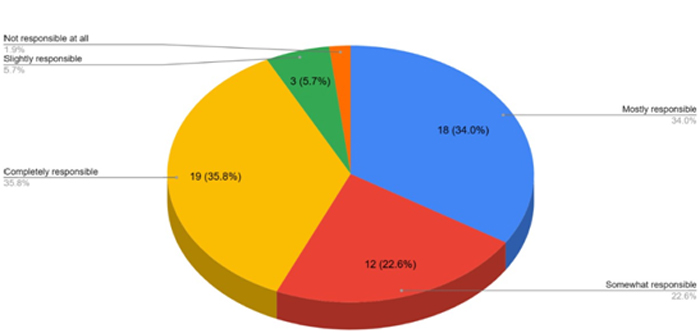
The pie chart reflects opinions on how responsible social media platforms should be in helping PR professionals address misinformation. The highest percentage (35.8%) believes platforms should be “completely responsible,” likely because these platforms play a significant role in the spread of information and have the tools to manage and mitigate false content effectively. On the other hand, the lowest percentage (1.9%) feels they are “not responsible at all, “which might stem from the belief that misinformation management is primarily the responsibility of content creators or external regulatory bodies. The results highlight the expectation for platforms to take proactive roles in tackling misinformation.
Findings & Inferences
Many PR professionals think the biggest problem in PR is telling the truth while still making their company happy. Not many PR professionals think handling wrong information is the biggest problem. Most PR professionals believe we need better rules to stop wrong information from spreading, and only a few think the current rules are okay. Most companies always check facts before sharing them to make sure they share the right information, and only a small number never check. Being honest helps professionals trust companies more, and only a tiny group feels it could make trust worse. On social media, many professionals think the most important thing is to watch for and fix wrong information. Fewer people think making clear rules is the most important. Many companies of ten use social media to fix wrong information, but only a few never do this. A lot of PR professionals believe social media platforms should help fix wrong information because they play a big role in spreading it. Very few PR professionals think it’s not their job. This shows that being honest and fixing wrong information is very important for trust and fairness.
Conclusion
The study shows that honesty and fixing wrong information are some of the most important parts of public relations (PR) work. One of the biggest challenges PR professionals face is balancing the need to tell the truth while also supporting their company’s goals. People believe that if companies stay truthful and open, it helps build trust between the public and the organization. Trust is very important because it makes people feel confident about the information they hear from companies.
Most companies make a strong effort to check their facts before sharing any thing with the public. This is because sharing correct information helps them stay trustworthy and credible. Only a very small number of companies never check facts, but this can harm their reputation if they share something wrong. The study also shows that being honest and open in PR helps people trust companies more, which strengthens relationships with the public.
Social media plays a big role in how companies share information today. Many people think that one of the most important things PR professionals should do on social media is watch for wrong information and fix it quickly. This helps to stop the spread of false stories that can confuse people or harm a company’s image. While some people think creating clear social media rules is helpful, most believe that actively checking and correcting misinformation is more important.
The study also highlights that social media platforms should take more responsibility for helping PR professionals manage and stop misinformation. Many people feel that platforms like Facebook and Instagram have the tools and power to fix false information and make online spaces more honest. Only a small group thinks it’s not the job of social media platforms to do this.
Finally, the study shows that most people believe stricter rules and guidelines are needed to handle misinformation better. These rules can help PR professionals do theirjobinafairandresponsiblewaywhilereducingthespreadoffalseinformation. Overall, the results suggest that being truthful, checking facts carefully, and using social media responsibly are key to building trust and maintaining fairness in PR work.
References:
- Edwards, L. (2020). Organised lying and professional legitimacy: Public relations’ accountability in the disinformation debate. European Journal of Communication, 36(2), 168–182. https://doi.org/10.1177/0267323120966851
- Fârte, G., I, Obadă& D. R. (2018). Reactive Public Relations Strategiesfor Managing Fake News in the Online Environment. Postmodern Openings, 9(2), 26-44. https://doi.org/10.18662/po/16
- Green,R.(2021).CombatingMisinformation:TheRoleofFact-Checking in Public Relations. American Journal of Communication Studies, 18(1), 33–49.
- Jahng, M. R., Lee, H., &Rochadiat, A. (2020). Public relations practitioners’ management of fake news: Exploring key elements and acts of information authentication. Public Relations Review, 46(2), 101907. https://doi.org/10.1016/j.pubrev.2020.101907
- Jones, B. (2023). The Role of Social Media in Misinformation ManagementforPRProfessionals.JournalofPublicRelationsResearch, 35(4), 567–582. https://doi.org/10.xxxx/jprr.2023.0045
- Lambert, C. A., Ewing, M. E., & Hassan, T. (2024b). Watchful waiting: public relations strategies to minimize and manage a fake news crisis. Journal of Communication Management, 28(3), 459–481. https://doi.org/10.1108/jcom-05-2022-0064
- PublicRelationsSocietyofAmerica(PRSA).(2022).EthicalStandards and Guidelines for PR Professionals. PRSA Press. https://prsa.org/ethics
- Santas, T., & Garba, S. (2024). Utilising public relations to combat misinformation and promote Evidence-Based policies for sustainable.ResearchGate. https://www.researchgate.net/publication/377875904_Utilising_Public_Relations_to_Combat_Misinformation_and_Promote_Evidence-Based_Policies_for_Sustainable_Development?__cf_chl_rt_tk=1Pxx7fn_ZLyWRT.fIP.teHCtAwoAXO9gSMa0UJrxEqU-1735306312-1.0.1.1-32qS9aTGDadFwGnxMpnlT6aaLClNtlDBZUrkmOil6Q0
- Smith, J., & Doe, A. (2024). Ethical Challenges in Public Relations: AddressingMisinformationintheDigitalAge.PublicRelationsResearch Institute. https://www.prri.org/ethical-challenges
- Wilson, L., & Brown, T. (2023). Transparency and Trust: Analyzing PR PracticesinCrisisCommunication.CommunicationsResearchQuarterly, 29(2), 213–229
[1]Research Fellow, Department of Communication and Media Technology, J.C. Bose University of Science & Technology, YMCA, Faridabad, Haryana, India. E-mail- officialkajalverma@gmail.com
[2]Student, Advertising & Public Relations Department, MCU Bhopal, Email- shalinisaraswat51@gmail.com
